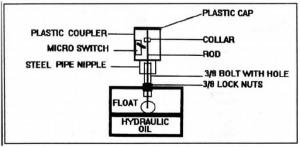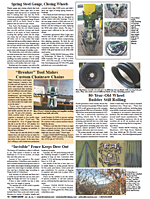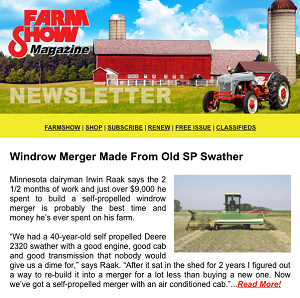Homemade Lw Hydraulic Fluid Sensor
 ✖  |
"I built a low hydraulic fluid sender unit for my 1470 I.H. combine out of parts from a local electronics store, hobby shop, junk yard, and hardware store. It lets me know immediately if there's a sudden drop in fluid level, such as when a hydraulic line breaks," says Dwight Alley of Wasco, Ore. "For about $27 in materials, I've got a system that works so well I plan to put one on my new 9150 Case-IH tractor."
He first drills a 3/8-in. dia. hole in the top of the hydraulic reservoir. Then he welds two lock nuts to the hole and inserts a hollowed out 3/8-in. bolt. A small steel rod with a gas tank float on the lower end extends up through the bolt and into a housing made out of PVC coupler. (The coupler screws into a steel pipe nipple that welds to the bolt). A small microswitch
mounts inside the housing and is triggered by a collar on the steel rod that rises and falls with the level of fluid in the reservoir.
When oil level in the reservoir drops, it activates the normally open micro-switch. This closes the contacts on the switch and activates the warning light and buzzer inside the combine cab.
"When the light comes on and the buzzer rings, it gives me plenty of time to stop the combine before I run the reservoir completely out of fluid, saving hundreds of dollars on repairs from severe wear on pumps and valves," Alley says.
Contact: FARM SHOW Followup, Dwight Alley, 69711 Gordon Ridge Road, Wasco, Ore. 97065 (ph 503 442-5278).

Click here to download page story appeared in.
Click here to read entire issue
Homemade Lw Hydraulic Fluid Sensor COMBINES Accessories 19-2-30 "I built a low hydraulic fluid sender unit for my 1470 I.H. combine out of parts from a local electronics store, hobby shop, junk yard, and hardware store. It lets me know immediately if there's a sudden drop in fluid level, such as when a hydraulic line breaks," says Dwight Alley of Wasco, Ore. "For about $27 in materials, I've got a system that works so well I plan to put one on my new 9150 Case-IH tractor."
He first drills a 3/8-in. dia. hole in the top of the hydraulic reservoir. Then he welds two lock nuts to the hole and inserts a hollowed out 3/8-in. bolt. A small steel rod with a gas tank float on the lower end extends up through the bolt and into a housing made out of PVC coupler. (The coupler screws into a steel pipe nipple that welds to the bolt). A small microswitch
mounts inside the housing and is triggered by a collar on the steel rod that rises and falls with the level of fluid in the reservoir.
When oil level in the reservoir drops, it activates the normally open micro-switch. This closes the contacts on the switch and activates the warning light and buzzer inside the combine cab.
"When the light comes on and the buzzer rings, it gives me plenty of time to stop the combine before I run the reservoir completely out of fluid, saving hundreds of dollars on repairs from severe wear on pumps and valves," Alley says.
Contact: FARM SHOW Followup, Dwight Alley, 69711 Gordon Ridge Road, Wasco, Ore. 97065 (ph 503 442-5278).
To read the rest of this story, download this issue below or click
here to register with your account number.







